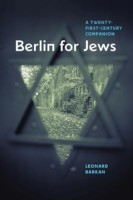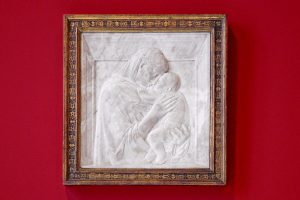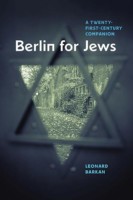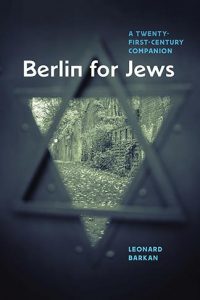Leonard Barkan’s BERLIN FOR JEWS

Princeton Professor Leonard Barkan is a polymath whose past books include MUTE POETRY, SPEAKING PICTURES and UNEARTHING THE PAST; ARCHEOLOGY AND AESTHETICS IN THE MAKING OF RENAISSANCE CULTURE.
Barkan’s latest book, BERLIN FOR JEWS, is a tour de force of writing about Germany’s capital city.
Recently, I caught up with Leonard Barkan for this interview.
1) Since you finished writing BERLIN FOR JEWS, have you learned anything about Berlin that surprised you?
Berlin is constantly surprising, particularly if you go there expecting a grey, half-ruined, half-Jerry-built, half East German (I know that’s too many halves) postwar city. Let me single out one detail, though. My partner and I now spend a lot of time in a certain corner of Kreuzberg. Our building is a modest construction from ca. 1900 — with graffiti throughout the hallway — and the outside is no better. Ditto for other buildings on the block. No tourist comes within several U-Bahn stops of us. Which is a pity, because, as I recently discovered, if you walk around the corner, you encounter a late nineteenth-century bridge over the Kreuzberg canal, and, if you look to the West along the water, what lies before you is a landscape of weeping willows as far as the eye can see; you might think you’re in the English Lake District.

(Photo of the Admiralbrücke in Kreuzberg, Berlin)
2) Please tell us about one of your favorite Italian works of art that is housed in Berlin and not discussed in this book.
Visitors to Berlin know about the Pergamon Altar and the Nefertiti head, both to be found on Museum Island, I am, however, obsessed with the nearby Bode Museum. The building in itself is beautiful, and its setting along the river utterly captivating. (Go there any summer night to dance by the Spree under the stars, to tunes spun by a great DJ.) My entry to the Bode Museum came because one of my Berlin Jewish heroes, James Simon, donated so many of the artworks housed in it. His collection, which is spread throughout the building, is mostly of Northern European works. But on the hunt for them, years ago, I discovered a diminutive relief sculpture by Donatello, a marble Madonna and Child. Worth the price of admission in itself: the faces of the two figures, which are touching (in both senses of the word), convey maternal love in a style as rapturous as it is serene. Plus, looking at this Donatello, you can see where the young Michelangelo got a lot of his ideas.

(Photo of Donatello’s Madonna and Child)
3) In the present, what do you think are the main characteristics distinguishing the Metropolitan Opera from opera in Berlin?
My spouse and I are opera lovers: we love the Met and we mourn the glory days of the New York City Opera (which may yet return!). (Ed. – the current New York City Opera’s website is here).
Berlin is opera lovers’ paradise, and we are especially attached to the Komische Oper. Not all the operas they perform are comedies (as their name implies), but their work, under the direction of the great Australian director Barrie Kosky, surprises, delights, infuriates, and — whatever else it does — remains unforgettable. Two of my most memorable experiences in any theater were their version of Handel’s Xerxes and, from quite a different century, their version of Kiss Me, Kate. You watch these strange and stylish productions and say to yourself; “I’m not in Lincoln Center any more.”
4) What are some of the main points you would hope to see an open-minded, non-Jewish Berliner take away from reading BERLIN FOR JEWS?
I called the book Berlin for Jews, but of course I’d be horrified to think that non-Jews felt excluded. The book is about Berlin, about Jewish Berlin, and about me, in descending order of importance. What I hope that every reader can discover in the book is an extraordinarily civilized city, a warm and enveloping city, a lively modern city, and, of course, a city marked in the most riveting way by history. And I hope the tone of the book will also suggest to readers that it’s a place to have every imaginable kind of fun. I’m a city boy: I grew up in Manhattan, and I’ve lived in Chicago, London, Paris, and Rome. Truth is, I love them all, and ten years ago I wrote a book (Satyr Square) about my life in Rome. At this moment, though, Berlin seems to me The Place—and that goes for everybody.
5) Please tell us a little about the historical Jewish Berliner Rahel Varnhagen, to whom you’ve devoted a chapter of Berlin for Jews.
At the end of the eighteenth and beginning of the nineteenth century, Rahel Varnhagen, a Jewish woman of no great fortune and (as people were all too ready to point out) no great beauty, was the doyenne of Berlin society. She knew everyone: Goethe called her “a beautiful soul,” and the misanthropic Beethoven played a private recital for her. Indeed, dozens of Teutonic worthies trooped up on Wednesday nights to her little attic rooms, where they would sip tea and discuss art, literature, politics, and love.
My book takes us through this remarkable society.
But I would single out one occasion where a different sort of visitor came to be enmeshed in the group. He’s a young foreigner with an insatiable desire to learn everything from everyone. He has already copied the gist of Hegel’s philosophy in a notebook. Among his fellow guests at the tea table, he asks a painter to give him the principles of portraiture, a singer to explain how she projects her voice, a general to impart the rules for winning a battle. Who is he, and where does he come from? His name is Albert Brisbane, and he hails from Batavia, New York. One of the regulars patronizingly writes, “He was such an amazing, and, in these parts, alien figure that a primordial human from those far-off regions, a veritable Redskin, would hardly have aroused more astonishment.” Rahel, does not, however, patronize him but rather takes him under her wing. In return, he helps crystallize in her a progressive and egalitarian world view.
****

At this link you may watch the book trailer for BERLIN FOR JEWS.
Leonard Barkan’s BERLIN FOR JEWS is here on Amazon and here on Barnes & Noble.

Another great Joanne interview! I’m particularly intrigued by the sharply etched cameos of Varnhagen and Brisbane. Will get this book!